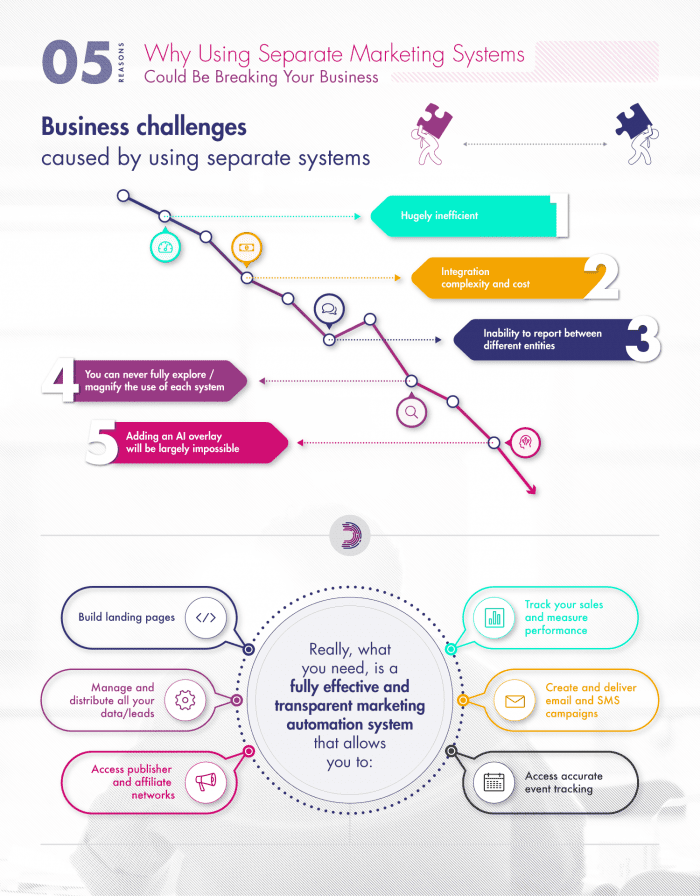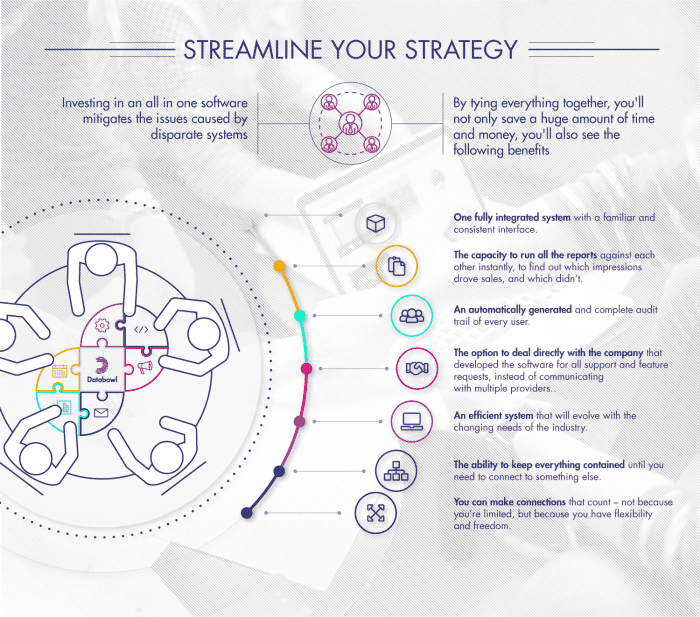Review the Business challenges caused by using separate systems and how you can overcome them
There’s nothing more counterproductive (and irritating!) than being in a situation where several people are trying to control what’s going on. It could be countless friends and associates giving you conflicting life advice, your entire family trying to plan your wedding, or a bunch of your colleagues who all think they know the best corporate tactics (when obviously, it’s you).
As an age-old proverb that has been extensively confirmed throughout the centuries, it can be true that “too many cooks spoil the broth”, and this definitely applies to your digital marketing endeavors…
One of the largest and most widespread problems in both marketing and advertising, is attempting to deliver top-end campaigns through the navigation of disparate systems. If you’re utilising multiple platforms for limited or singular purposes, you’re only going to overcomplicate matters, decrease your potential for positive results, and make stupid mistakes.
Really, what you need, is a fully effective and transparent marketing automation system that allows you to:
- Build landing pages
- Manage and distribute all your data/leads
- Access publisher and affiliate networks
- Track your sales and measure performance
- Create and deliver amazing email and SMS marketing campaigns
- Access accurate event tracking
In an era of automated everything, businesses are under colossal amounts of pressure to up their marketing game, but the proper planning required to implement an integrated marketing management software system often takes a back seat to short-term revenue acceleration goals. This may seem like a good idea at the time, but you’ll fast learn that it’s is a big mistake.
Trying to juggle compliance and control over several systems in the age of GDPR is a lawsuit waiting to happen, or at best, it will massively decrease your overall efficiency. Without integrated and holistic visibility to comprehensive detailed marketing information, it is difficult to identify problems that exist throughout your campaigns — and next to impossible to fix them.
Business challenges caused by using separate systems
1. Hugely inefficient
This is probably the biggest and most debilitating problem of all. Using separate systems to achieve a common marketing goal is like playing Chinese Whispers in the middle of a rock concert – pretty damn difficult!

With your marketing strategy needing several components to work effectively, using different systems for each element is time-consuming, subject to failure and a complete waste of resource. When your company is attempting to evolve, every employee must be operating at optimal productivity. If your employees are bogged down with inefficient and disjointed processes, it increases errors and takes time away from other duties.
2. Integration complexity and cost
With so many interfaces to set up, you waste a massive amount of time and money on integrating and maintaining these systems. Miscommunication between platforms is inevitable, and programming all applications to work seamlessly together is impossible. In addition to this, enabling a basic compatibility is often convoluted and ineffective. Consequently, valuable time that could be used to make the business more productive is wasted, while maintenance and training costs skyrocket.
3. Inability to report between different entities
Often using up to 4 disparate systems to control your landing page building, affiliate tracking, lead management/distribution and publisher network, all your reporting is equally and selectively limited.
While manually attempting to find links between individual results from various applications, you’re subject to numerous mistakes and inaccuracies. Missing correlations that would be better ‘spotted’ by machine automation, you could be losing out on a huge number of customers.
4. You can never fully explore/magnify the use of each system
Already trying to cram too much information into your fraught and over-worked head? Thought so. Attempting to navigate 4 different systems is tricky enough without delving even further into what is on offer.
Investing in platforms for singular purposes means that you overlook key features, and pay far too much money for what you’re getting. If you multiply that by the number of systems you’re using, you’ll find that the volume of money you’re throwing away is frightening.
5. Adding an AI overlay will be largely impossible
Along with ‘automated everything’, Artificial Intelligence and Machine Learning are rapidly becoming standard practice, but if you’re already using disparate systems, adding AI to your strategy is going to be ridiculously difficult, because:
- All the data and information from each piece of software is only connected by the plug-ins you create between them. This means you could be missing key information from one of the platforms, as it's not important to the activities you're carrying out.
- The complications of deciding how exactly to use AI are manifold. Would you install another platform (how many?!), or use one of your current systems, in which case you’ll have to manually input the information from everywhere else, leading to more work and complications?
- Collating all the information from each piece of software would be laborious. Getting the data into a usable format will be hard enough, without even starting to apply machine learning to it.
- Making headway with static information will be arduous at best. It misses the whole point of having a self-learning machine that can run based on the information going into it in real time. You will be biased and using old information almost immediately.
- Machine Learning algorithms are extremely sensitive to changes in data formatting, order, and type, and it’d be very hard to ensure that nothing changed. Updates from one of your multiple systems could break it.
Streamline your strategy
Investing in a software that mitigates these issues by tying everything together, not only will you save a huge amount of time AND money, you’ll also see the following benefits:
- One fully integrated system with a familiar and consistent interface
- The capacity to run all the reports against each other instantly, to find out which impressions drove sales, and which didn’t
- The option to deal directly with the company that developed the software for all support and feature requests, instead of communicating with multiple providers
- An automatically generated and complete audit trail of every user
- An efficient system that will evolve with the changing needs of the industry
- The ability to keep everything contained until you need to connect to something else. You can make connections that count – not because you’re limited, but because you have flexibility and freedom

So instead of gathering your colleagues and employees in a last-ditch attempt to save your current software approach, why don’t you simply change it? 2018 is for streamlining your marketing strategy, growing your business - and making sure that you carry all the tools to do so in one manageable little package!
Out with the old and in with the new…put an all-in-one, transparent marketing automation platform on your Christmas list this year...
Thanks to Hannah Crowley for sharing their advice and opinion in this post. Hannah is the Marketing Coordinator and Copywriter for rapidly expanding software company
Databowl. Responsible for heading up the marketing endeavours for the company, she also keeps abreast of the latest marketing and tech trends to ensure that Databowl stays ahead of the curve and offers clients the best solutions. You can follow her on
Twitter or connect on
LinkedIn.








